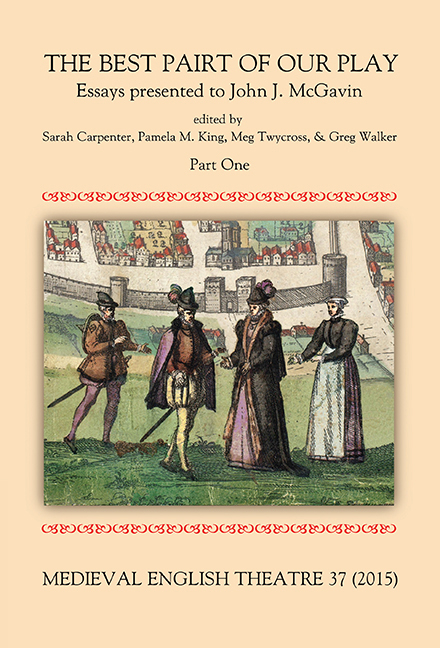Book contents
- Frontmatter
- Contents
- Epigraph
- Editorial
- In honorem John J. McGavin
- John J. McGavin: Bibliography
- The Places of Foolery: Robert Armin and fooling in Edinburgh
- George Bannatyne's ‘Sertane Mirry Interludis’, and Sir David Lyndsay's play
- The Linlithgow Interlude of 1540 and Lyndsay's Satire of the Thrie Estaitis
- Stage Directions in Lyndsay's Ane Satire of the Thrie Estaits
- The Dramatic Voice of William Dunbar
- How to Track a Bear in Southwark: a learning module
- The Digby Mary Magdalen in Performance: a merry peripeteia
- ‘Thus am I Rent on Rode’: taking apart the Towneley Crucifixion
- The Second Shepherds' Play: a play for the Christmas season
- ‘They did not come out of an Abbey in Lancashire’: Francis Douce and the manuscript of the Towneley Plays
- EDITORIAL BOARD (2015)
‘Thus am I Rent on Rode’: taking apart the Towneley Crucifixion
Published online by Cambridge University Press: 05 March 2016
- Frontmatter
- Contents
- Epigraph
- Editorial
- In honorem John J. McGavin
- John J. McGavin: Bibliography
- The Places of Foolery: Robert Armin and fooling in Edinburgh
- George Bannatyne's ‘Sertane Mirry Interludis’, and Sir David Lyndsay's play
- The Linlithgow Interlude of 1540 and Lyndsay's Satire of the Thrie Estaitis
- Stage Directions in Lyndsay's Ane Satire of the Thrie Estaits
- The Dramatic Voice of William Dunbar
- How to Track a Bear in Southwark: a learning module
- The Digby Mary Magdalen in Performance: a merry peripeteia
- ‘Thus am I Rent on Rode’: taking apart the Towneley Crucifixion
- The Second Shepherds' Play: a play for the Christmas season
- ‘They did not come out of an Abbey in Lancashire’: Francis Douce and the manuscript of the Towneley Plays
- EDITORIAL BOARD (2015)
Summary
Much like the manuscript in which it is found, the Towneley Crucifixion is a composite work, imperfectly pieced together from diverse original sources. Some of its interesting features pose problems for anyone who deems the collection of plays in the manuscript to be a performable sequence: for example, it includes one of two different representations of the gambling for Jesus's robe, but lacks a representation of the burial of Jesus, which is not otherwise dramatised in the collection. It also lacks the two thieves traditionally crucified alongside Jesus and, unlike the other Towneley plays that deal with the Passion, involves four rather than three Torturers. Such details create notable discontinuity in a series of plays that, according to Martial Rose, ‘sweeps on in continuous action from play to play and from stage to stage’ — a view of the plays as a unified cycle that was questioned long before Rose's modernisation, but still dominates Towneley criticism. Yet the play poses some interesting staging issues even on its own, considered as a possible stand-alone production, largely due to the ways in which the disparate source texts have been edited together. Jesus is left hanging for an unusually long time on the Cross, which is repeatedly dropped in the mortise, while John and Mary utter traditional lyrical laments and then abruptly vanish from the text. This paper represents an attempt to pull the play apart and examine some of its constituent parts in order to examine how the play might have been expected to be performed, if indeed it was composed or revised with performance in mind.
The portion of the play that deals with the Crucifixion itself is written in a 6-line stanza rhyming aabccb — a stanza form used in several other plays in the collection, including those of the Advent sequence. The play begins, however, with Pilate ranting in three different stanza forms, one of which is the 13-line ‘bob and wheel’ stanza associated with the putative ‘Wakefield Master’. The character is here represented as utterly Other, swearing ‘By Mahownys bloode’ in one stanza (14) and introducing himself as ‘Prynce of all Jury’ in the next (23). He repeatedly and bombastically calls for ‘peasse’ (1, 8, 9, 13) while threatening violence, then suddenly falls silent for 580 lines.
- Type
- Chapter
- Information
- Medieval English Theatre 37The Best Pairt of our Play. Essays presented to John J. McGavin. Part I, pp. 119 - 133Publisher: Boydell & BrewerPrint publication year: 2015



